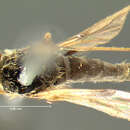Comprehensive Description
provided by Memoirs of the American Entomological Society
Chrysopilus flavibarbis Adams
1904. Chrysopilus flavibarbis Adams, Kans. Univ. Sci. Bui., II, p. 438, 1904.
Velvety blackish to brownish black; pile of cheeks pale golden yellow; thorax sparsely, abdomen rather thickly clothed with golden tomentum; halteres with stem yellowish brown, knobs infuscated; femora dark brownish, tibiae brownish yellow; wings with stigma distinct; membrane with distinct brownish tinge.
Female. — Length, 5 mm. Head: Front brownish pollinose; face grayish pollinose; palpi and proboscis blackish; hairs of vertex, front, sides of face, occiput, palpi and proboscis, pale yellowish ; front with a small patch of dark pile on either side near eyes and just below ocelli; antennae blackish.
Thorax: Mesonotum a velvety blackish, except a small area in front, the lateral margins including the humeri, and the posterior margin, which are grayish pollinose; a faint grayish median line extends from the front about two-thirds the distance to the scutellum; scutellum dark brownish; both mesonotum and scutellum are sparsely covered with short yellowish somewhat appressed hairs; pleura light grayish pollinose, bare; knob of halteres blackish, base yellowish brown.
Abdomen: Brownish pollinose, rather thickly clothed with short golden yellow, somewhat appressed, hairs.
Legs: Coxae light grayish pollinose, with a few rather long, golden hairs; trochanters and femora, except tip of latter, dark brownish, with a sparse covering of short golden hairs; tip of tibiae and of metatarsus and all the rest of the tarsi inf uscated ; legs otherwise yellowish brown.
Wings: Veins brown; stigma distinct, brownish; membrane noticeably tinged with brownish, slightly darker along veins, membrane somewhat paler in anal region.
Male. — Length, 5 mm. Mesonotum velvety black and abdomen blackish except towards tip which is brownish ; otherwise like the female.
The above description was drawn up from three specimens: that of the female from a co-type marked "Colo. 1936" kindlyloaned me by Mr. C. W. Johnson from his collection, that of the male from one specimen from Gallatin County, Montana, (E. S. Moore), July 20, 1901, and another from Bozeman, Montana, July 23, 1915. Both specimens appear to be somewhat rubbed, the bristles of the antennae of the female are broken off and the halteres are lacking. I have also seen : Two males, Powell County, Montana, [A. L. Melanderjone retained]; one male, Bozeman, Montana, 4800 feet alt., July 1 ; and a male, June 25, 1900, (E. Koch), [Wash. Sta. Coll. ; A. L. Melander det.] ; four males, Emigration Canyon, Utah, July 21, 1917 [U. S. N. M., ex. Aldrich]. The species was described from seven specimens from Colorado and Wyoming, the Colorado specimens being in the C. W. Johnson Collection. E. S. Tucker (1907) records it from Colorado Springs in August with the note "compared with types."
- bibliographic citation
- Leonard, M.D. 1930. A Revision of the Dipterous Family Rhagionidae (Leptidae) in the United States and Canada. Memoirs of the American Entomological Society vol. 7. Philadelphia, USA

